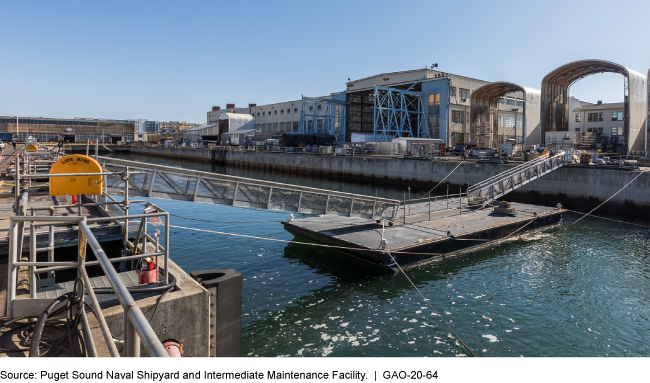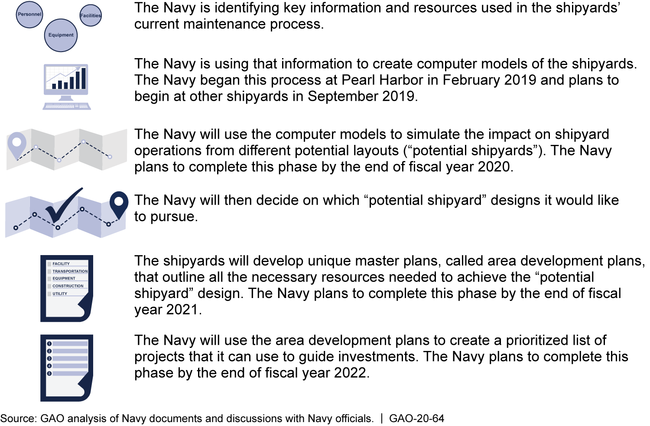Naval Shipyards: Key Actions Remain to Improve Infrastructure to Better Support Navy Operations
Fast Facts
The Navy’s public shipyards are critical to maintaining its nuclear-powered aircraft carriers and submarines, as well as supporting its operations around the world. In 2017, we found the shipyards were in poor condition and not meeting the Navy’s needs. In response, the Navy developed a 20-year, $21 billion plan to fix them.
However, we found the preliminary plan’s cost estimate is likely understated by billions of dollars. It is missing key elements such as adjustments for inflation, environmental remediation, and utility upgrades.
We recommended that the Navy include these missing elements when it produces its more detailed cost estimate.
Puget Sound’s Dry Dock 3, built in 1919, is too shallow, not certified to handle nuclear fuel, and requires upgrades.

Shipyard
Highlights
What GAO Found
The Navy's 2018 Shipyard Infrastructure Optimization Plan includes actions to address critical deficiencies at the shipyards, but the extent to which the plan fully addresses those deficiencies remains to be seen as the proposed actions are complex and years away from being implemented. The plan includes steps to address dry dock deficiencies, which the Navy expects willl provide it with the capacity and capability to perform 67 of 68 ship maintenance periods it is currently unable to support through fiscal year 2040. Once area development plans are complete (see figure), the Navy projects it will take at least $21 billion over 20 years to fully implement the plan.
Figure: Navy's Planned Activities to Address Shipyard Deficiencies through 2022

The Navy's initial cost estimate for the plan did not use certain best practices in developing the estimate, such as documenting key assumptions, accounting for inflation, and addressing risks that together could add billions to the ultimate cost. Navy officials stated that high-quality cost estimates will not be possible until they complete modeling and simulation in fiscal year 2020 and subsequently identify the most effective shipyard layouts and prioritize projects in fiscal year 2022. However, without fully following best practices in subsequent estimates, the Navy risks requesting inadequate resources to address shipyard deficiencies.
The Navy created a program management office in June 2018 to oversee the estimated 20-year-long process of optimizing the shipyards. This program office includes representatives from multiple Navy organizations. However, the office has not formally defined the role of shipyard officials. Navy officials stated that they intend to develop an agreement to address roles and responsibilities, but this has not yet been finalized. Without defining clear shipyard roles and responsibilities, the Navy risks an ineffective implementation of its plan.
Why GAO Did This Study
The poor condition of infrastructure at the Navy's four public shipyards—Norfolk Naval Shipyard, Virginia; Portsmouth Naval Shipyard, Maine; Puget Sound Naval Shipyard, Washington; and Pearl Harbor Naval Shipyard, Hawaii—affects the readiness of the aircraft carrier and submarine fleets they are charged with maintaining. In response to congressional direction to create a plan to address the shipyards' infrastructure deficiencies, the Navy developed the Shipyard Infrastructure Optimization Plan , which the Navy estimates will require $21 billion and 20 years to implement.
Senate Report 115-262 accompanying a bill for the National Defense Authorization Act for Fiscal Year 2019 included a provision for GAO to review the Shipyard Infrastructure Optimization Plan . GAO evaluated the extent to which the plan (1) addresses deficiencies in the infrastructure needed to support the Navy's projected needs, (2) includes reliable cost estimates to address those deficiencies, and (3) identifies clear roles and responsibilities for implementation. GAO reviewed the Navy's shipyard infrastructure plan and cost estimates; conducted site visits to shipyards selected to provide a variety of operational perspectives; and interviewed Navy and shipyard officials.
Recommendations
GAO recommends that the Navy enhance the quality and reliability of its shipyard infrastructure plan by incorporating GAO's cost estimating best practices and determining clear shipyard roles and responsibilities for implementing the plan. The Navy concurred with these recommendations.
Recommendations for Executive Action
| Agency Affected | Recommendation | Status |
|---|---|---|
| Department of the Navy | The Secretary of the Navy should ensure that the shipyard optimization program office (PMS 555) include all costs—such as costs for program office activities, utilities, roads, environmental remediation, historical preservation, and alternative workspace—when developing its second, more detailed, cost estimate. (Recommendation 1) |
Navy officials concurred with this recommendation. As of April 2024, Navy officials told us that they expect to update the SIOP cost estimate after they complete the shipyard-specific plans. Those are currently scheduled to be complete by fiscal year 2026. The first shipyard-specific plan, for Pearl Harbor, did include these additional costs, namely program office activities, utilities, roads, environmental remediation, historical preservation, alternate workspace and inflation. This is an encouraging sign, and if the other shipyard-specific plans include these costs as well, the Navy will be well positioned to implement this recommendation. As a result, the Navy estimates that it will not complete implementation of this recommendation until the end of fiscal year 2026.
|
| Department of the Navy | The Secretary of the Navy should ensure that the shipyard optimization program office (PMS 555) use cost estimating best practices—as outlined in the GAO Cost Estimating and Assessment Guide—in developing its second cost estimate, including a program baseline, work breakdown structure, a description of the methodology and key assumptions, inflation, fully addressing risk and uncertainty, and a sensitivity analysis. (Recommendation 2) |
Navy officials concurred with this recommendation. The Navy has taken clear steps to implement this recommendation. For example, in January 2023, Naval Facilities Engineering Systems Command and the Navy's Program Executive Office for Industrial Infrastructure signed a joint memo to provide additional guidance on using cost estimating best practices. This memo states that SIOP and supporting organizations will use GAO best practices, and provides explanations for how these best practices will be reviewed at both the program and the project level. All twelve of the GAO best practices for cost estimating are included in the memo, and we are encouraged by the Navy's steps in this respect. As of April 2024, SIOP is advancing along the Major Defense Acquisition Program (MDAP) processes. Following the MDAP process, SIOP will reach Milestone B (Engineering and Manufacturing Development Phase) in 2026. Reaching this program milestone requires the completion of an Area Development Plan (ADP) for each of the four shipyards. The remaining three ADPs are in progress and are scheduled to be complete in 2026. At that point we will be able to assess whether the SIOP used cost estimating best practices.
|
| Department of the Navy | The Secretary of the Navy should ensure that the shipyard optimization program office (PMS 555) obtain an independent cost estimate of the Naval Shipyards program prior to the start of its project prioritization effort. (Recommendation 3) |
Navy officials concurred with this recommendation. As of November 2024, the Navy is developing shipyard-specific infrastructure plans that will serve as the basis for the full SIOP cost estimate. The first, for Pearl Harbor, included an independent cost estimate, and was completed in 2023. Navy officials tell us that the remaining plans will be complete by the end of FY26. It seems unlikely that the Navy will be able to produce an independent cost estimate for the SIOP until those plans identify the projects that will make up the SIOP. However, some projects already have a statutory requirement to develop an independent cost estimate. The FY22 National Defense Authorization Act included a provision that required the Navy to provide either updated or independent cost estimates for all projects with contracts awarded after October 2024 that cost more than $250 million. The Navy must provide that new estimate prior to the beginning of construction. In order to fully implement this recommendation, the Navy must determine what projects will be a part of the SIOP and obtain independent cost estimates for all appropriate projects.
|
| Department of the Navy | The Secretary of the Navy should ensure that the shipyard optimization program office (PMS 555), in coordination with relevant stakeholders, establish clear roles and responsibilities for the shipyards involved in the Shipyard Infrastructure Optimization Plan. (Recommendation 4) |
DOD concurred with this recommendation. In fiscal year 2020, Naval Sea Systems Command issued guidance that, among other things, outlined the staffing, roles, responsibilities, and business rules for the Shipyard Infrastructure Optimization Program (SIOP), Program Management Office (PMS 555) at the four public Naval Shipyards (NSY). This action met the intent of this recommendation.
|
